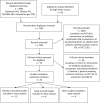Antibiotics for Preventing Recurrent Urinary Tract Infection: Systematic Review and Meta-analysis
- PMID: 35899289
- PMCID: PMC9310516
- DOI: 10.1093/ofid/ofac327
Antibiotics for Preventing Recurrent Urinary Tract Infection: Systematic Review and Meta-analysis
Abstract
Recurrent urinary tract infections are a common health problem. The only comprehensive synthesis on antibiotic prophylaxis in the last 15 years has been a guideline-embedded meta-analysis. We conducted a systematic review and meta-analysis of randomized controlled trials published up to October 13, 2020, evaluating patients age ≥12 years with either ≥2 episodes of lower urinary tract infection (UTI) within 6 months or ≥3 in the past year. Placebo or antibiotics were allowed as comparators. Study quality was low. In the 11 placebo-controlled trials, the risk for developing UTI was 85% lower with prophylaxis in comparison with placebo (risk ratio [RR], 0.15; 95% CI, 0.08-0.29). In the 9 head-to-head trials, the efficacy of the antibiotic agents appeared similar: The pooled RR indicated no difference between nitrofurantoin and comparators (RR, 1.01; 95% CI, 0.74-1.37), nor trimethoprim (+/- sulfamethoxazole; RR, 1.34; 95% CI, 0.89-2.03) or norfloxacin and comparators (RR, 1.17; 95% CI, 0.43-1.70). Studies comparing intermittent (postcoital) with continuous strategies revealed intermittent application to be equally effective.
Keywords: UTI; antibiotic prophylaxis; cystitis; meta-analysis; recurrent urinary tract infection.
© The Author(s) 2022. Published by Oxford University Press on behalf of Infectious Diseases Society of America.
Figures



References
-
- Muller AE, Verhaegh EM, Harbarth S, Mouton JW, Huttner A. Nitrofurantoin’s efficacy and safety as prophylaxis for urinary tract infections: a systematic review of the literature and meta-analysis of controlled trials. Clin Microbiol Infect 2017; 23:355–62. doi:10.1016/j.cmi.2016.08.003 - DOI - PubMed

